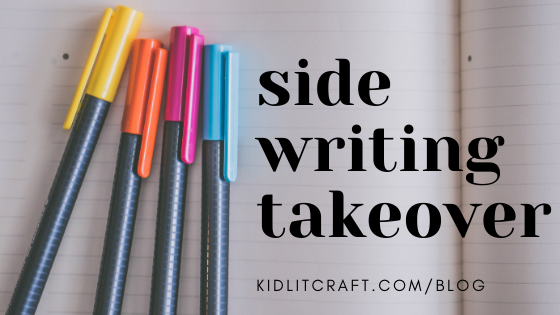interview by Erin Nuttall
Sidewriting Takeover brings together writers of picture books, middle grade, and young adult to explore how writing outside of a draft can help deepen your drafts and revisions. Each writer shares an exercise that they’ve found helpful. If you missed our initial post: START HERE.
Not too long ago, I had the good fortune to take a workshop from Jenny. I already knew how kind, smart, generous, and funny she is, so I knew I’d have a great experience and learn a lot in the workshop. What I didn’t expect is that she would show me the true power of sidewriting. Thanks to Jenny, I finally understood how the things I discovered about the characters through sidewriting could drive the plot. They’d always been these disparate ideas for me but she linked them in a way that changed my writing. After you check out her interview, I’d love to hear what you learned or how your thinking changed. —Erin
KidLit Craft: Were you always a side writer?
Jenny Ziegler: I believe so. Early in my career I did a lot of work-for-hire writing – TV tie-in novels and teen paperback series like Sweet Valley High Senior Year. That’s when I learned to do structural exercises like outlines, timelines, maps and calendars that would help me adhere to the backstory and keep track of important details as I drafted. But even before then, while I was growing up, I did a lot of what I thought of as “playtime with characters,” like writing letters or diary entries in their voice. This is also sidewriting, but for me it was just fun.
KLC: How has sidewriting become a part of your writing process?
JZ: I realized that all that early sidewriting – on my own and for hired work – helped me understand my world, my characters, and the structure of my story, all of which made drafting easier. Before I began outlining as part of my process, I would often get lost in my own story, and I abandoned many novel drafts that I began during my teens and college years. Similarly, whenever I’ve tried writing before I really know my main character, I wouldn’t feel as connected to the story. This makes the character hard to relate to and their actions hard to understand. Now I make sure I have all those things in place before I get too far into a draft. It’s easier to prevent problems than it is fixing them in rewrites. (Although it doesn’t solve everything. I still have to revise quite a bit.)
KLC: At what points in the process of writing a novel do you side write most?
JZ: It’s different for every writer. And for each writer, it’s different with every project they undertake. Sidewriting can be done at any stage of the process. But generally speaking, I do most sidewriting early – either before I’ve started drafting or when I’m just a few chapters in.
I always start with character. For me, that’s the spark that makes me want to write. Who is this person in my head? What are they grappling with? What do they need to figure out (about themselves and/or life in general)? To answer these questions, I write scenes about them and sometimes in their voice.
Once I know the protagonist (their personality, goals, backstory, etc.), that’s when I start the structural work. I make a rudimentary outline to get the big picture, checking to see that plot turns are in the right place and that my intro or resolution isn’t too long.
When I feel the bones of the story are good shape, I add in more specifics and break the plot into scenes and chapters. Sometime around this point I start drafting, but I keep tweaking the outline as I go – adding details, thematic questions, or reminders to myself to research a reference, redo something, and so on.
KLC: How does sidewriting help you?
JZ: Sidewriting helps me understand integral components of my story removed from everything else. I can focus on just character, or just structure, or use a calendar to better track the passage of time. If I try to analyze these elements in the draft, I get distracted by other things – or the story itself.
KLC: As a teacher, how do you ask/encourage students to engage with sidewriting?
JZ: It depends on the student and their needs. One might need help with structure and logistics, so I’ll bring up doing an outline or calendar or timeline or map. Someone else might need to better understand their protagonist, so I’ll suggest writing letters or journal entries as their main character, or drafting a scene that won’t end up in the book but will reveal their character’s inner core. I usually suggest the exercises, but occasionally I will assign them.
Can you share a few examples of your favorite sidewriting exercises?
Sure. I’ve already mentioned a few of them. Things like calendars that cover the time span of the story or maps of the setting are pretty obvious. But here are a couple of my favorite prompts for discovering more about your main character:
Sidewriting Challenge: Travel through Time
What was your protagonist doing one year before the start of your story? Five years? Ten? Write a scene that lets you peek into their past. It can be a pivotal event – a loss, a triumph, a harrowing or embarrassing event that haunts them still, or the moment they first met someone important to them. Or it could be just a regular day. Perhaps a scene of them at work or school or hanging out with friends or family. Sometimes these “mundane” scenes can show you their default settings – who they were before the inciting incident of your story.
Similarly, you might ask yourself what your protagonist will be doing a year after the end of your story. Or five, ten, twenty years later. Write a scene that shows a glimpse into their future. Knowing where your character will end up in life can reveal all sorts of things, like what they need to learn about themselves and/or the world, what they need to unlearn, what fears they need to overcome.

Jennifer Ziegler is the author of the middle grade Brewster Triplet Series for Scholastic—Revenge of the Flower Girls, Revenge of the Angels, Revenge of the Happy Campers, and Revenge of the Teacher’s Pets—as well as three young adult novels for Penguin Random House—How Not to Be Popular, Sass & Serendipity, and Alpha Dog.
Her books have been featured on the Lone Star List, the International Reading Association’s Young Adults Choice List, recommended on NPR’s “Tell Me More,” and optioned for film and stage. She teaches writing at Vermont College of Fine Arts, Writing For Children and Young Adults program. Visit her at jenniferziegler.net.
For more in our Sidewriting Takeover series, check out our interview with Karen Krossing on interviewing your characters.
To subscribe to our monthly newsletter, click here:
Erin Nuttall holds an MFA in Writing for Children and Young Adults from Vermont College of Fine Arts and is an active member of SCBWI and ALAN. She lives outside of Chicago with her family where she writes stories for middle grade and young adult readers that offer a humorous take on friendship, identity, feminism, and romance.





I enjoyed this interview, thanks Erin! I’ve always resisted side writing [SW] and used it occasionally. I did use the “look ahead” exercise to imagine whether my character grew up to be Carl Hayden or … someone else in early drafting. That was revealing. But I’m returning to SW again now after reverse outlining my completed WIP for revision, and seeing character holes. Jenny your insights and advice will really help. I may become a convert yet!
Ack!! …whether my character grew up to be Carla Hayden (the librarian of Congress) NOT Carl.